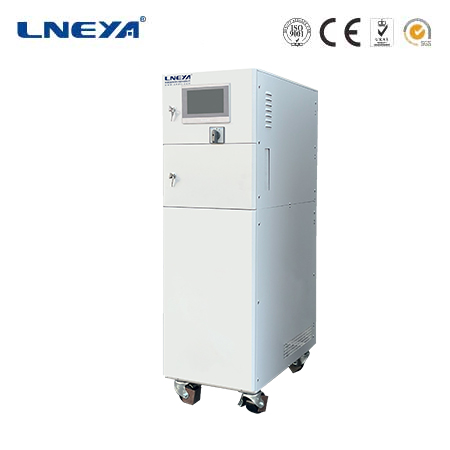working of air cooled chiller
Working of Air Cooled Chiller
An air-cooled chiller is a type of refrigeration system that is widely used to provide cooling for a variety of applications, including commercial buildings, industrial processes, and data centers. Unlike water-cooled chillers that use water as a heat transfer medium, air-cooled chillers rely on ambient air to reject heat.

Core Components of an Air-Cooled Chiller
Compressor: The compressor is the heart of the air-cooled chiller. Its main function is to increase the pressure and temperature of the refrigerant. It takes in low-pressure, low-temperature refrigerant vapor from the evaporator and compresses it, raising its pressure and temperature significantly. This compression process is crucial as it initiates the refrigeration cycle by preparing the refrigerant for the next stage of heat transfer.
Condenser: After the refrigerant leaves the compressor as a high-pressure, high-temperature vapor, it enters the condenser. The condenser is a heat exchanger where the refrigerant releases its heat to the ambient air. Fins and fans are often used in the condenser to enhance the heat transfer process. As the refrigerant cools down in the condenser, it condenses from a vapor into a liquid. The heat absorbed by the air is then dissipated into the surrounding environment.
Expansion Valve: The liquid refrigerant from the condenser then flows through the expansion valve. The expansion valve is a critical component that reduces the pressure of the liquid refrigerant. As the pressure drops, the refrigerant flashes into a mixture of liquid and vapor at a much lower temperature. This sudden expansion also causes a cooling effect on the refrigerant.

Evaporator: The mixture of liquid and vapor refrigerant enters the evaporator. In the evaporator, the refrigerant absorbs heat from the medium that needs to be cooled (such as chilled water in a building’s cooling system). As the refrigerant absorbs heat, the remaining liquid refrigerant vaporizes, and the resulting low-pressure refrigerant vapor is then drawn back into the compressor to start the cycle again.
The Working Cycle of an Air-Cooled Chiller
Compression: The compressor draws in the low-pressure refrigerant vapor from the evaporator. It compresses the vapor, increasing its pressure and temperature. This is an adiabatic process (assuming no heat transfer to the surroundings during compression), and the work done by the compressor increases the internal energy of the refrigerant.
Condensation: The high-pressure, high-temperature refrigerant vapor enters the condenser. Heat is transferred from the refrigerant to the ambient air passing over the condenser coils. As the refrigerant loses heat, it condenses into a liquid state. The air, in turn, is heated up and blown away from the chiller.
Expansion: The liquid refrigerant passes through the expansion valve. The valve restricts the flow of the refrigerant, causing a significant drop in pressure. This pressure drop leads to the refrigerant partially vaporizing and cooling down to a much lower temperature.

Evaporation: The low-temperature, low-pressure mixture of liquid and vapor refrigerant enters the evaporator. Here, it absorbs heat from the substance being cooled (e.g., water or air in a cooling application). The heat absorption causes the remaining liquid refrigerant to vaporize, and the resulting low-pressure vapor is then returned to the compressor to continue the cycle.
The Role of Refrigerant and Air
The refrigerant is the medium that undergoes phase changes (from vapor to liquid and vice versa) during the chiller’s operation, facilitating the transfer of heat. Different types of refrigerants are used depending on various factors such as environmental considerations and performance requirements. Air, on the other hand, serves as the heat sink in an air-cooled chiller. The fans in the condenser blow air over the condenser coils, enabling the transfer of heat from the refrigerant to the air. This heat transfer is essential for the proper functioning of the chiller and for maintaining the desired cooling effect.
In conclusion, the operation of an air-cooled chiller is a complex yet highly efficient process that relies on the coordinated functioning of its components and the principles of thermodynamics. By understanding how these components work together and the role of the refrigerant and air, one can better appreciate how air-cooled chillers provide effective cooling for a wide range of applications.
Related recommendations
heater manufacturing company
279Heater Manufacturing Company: A Complete Guide Introduction Heater manufacturing companies play a crucial role in providing efficient and reliable heating solutions for various applications....
View detailswater chiller price list
374Water Chiller Price List: Understanding the Factors That Influence Costs Water chillers are indispensable for various applications, from HVAC systems in commercial buildings to industrial proce...
View detailsWhat is the maintenance method for non circulating cold water in chiller for laboratory?
925What is the maintenance method for non circulating cold water in chiller for laboratory? The water level in the water tank is lower than the water inlet of the water pump Solutio...
View detailswater cooled chiller maintenance
219Water Cooled Chiller Maintenance: Key Knowledge and PracticesWater cooled chillers play a vital role in various industrial and commercial applications by providing efficient cooling. To ensure the...
View details
 LNEYA Thermal Test Chillers
LNEYA Thermal Test Chillers







HelloPlease log in